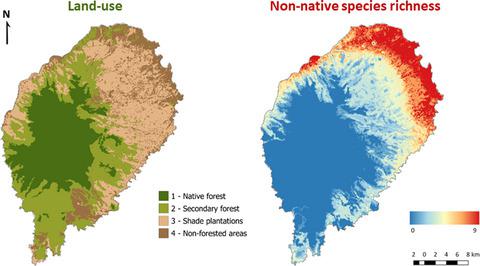当前位置:
X-MOL 学术
›
Anim. Conserv.
›
论文详情
Our official English website, www.x-mol.net, welcomes your
feedback! (Note: you will need to create a separate account there.)
Land‐use intensification promotes non‐native species in a tropical island bird assemblage
Animal Conservation ( IF 2.8 ) Pub Date : 2020-02-24 , DOI: 10.1111/acv.12568 F. C. Soares 1, 2 , M. Panisi 1, 2 , H. Sampaio 3 , E. Soares 4, 5 , A. Santana 4 , G. M. Buchanan 6 , A. I. Leal 1, 2, 7 , J. M. Palmeirim 1, 2 , R. F. Lima 1, 4
Animal Conservation ( IF 2.8 ) Pub Date : 2020-02-24 , DOI: 10.1111/acv.12568 F. C. Soares 1, 2 , M. Panisi 1, 2 , H. Sampaio 3 , E. Soares 4, 5 , A. Santana 4 , G. M. Buchanan 6 , A. I. Leal 1, 2, 7 , J. M. Palmeirim 1, 2 , R. F. Lima 1, 4
Affiliation

|
Habitat loss and non‐native species are two key drivers of biodiversity decline. The importance of their interactions is widely recognized, but remains poorly understood. We used the endemic‐rich bird assemblage of São Tomé Island to study this type of interactions. We built species‐specific binomial generalized linear models for 33 terrestrial bird species, based on presence–absence data from 2398 sampling points. Meta‐analysis techniques revealed that land use was more important in explaining distribution than topographic variables, rainfall, or distance to coast for the studied bird species. Native species were more likely to occur in remote rainy forests at higher altitudes, whereas non‐native species were more likely to occur in non‐forested ecosystems, being associated with humanized lowland areas in the drier flat regions of São Tomé. The susceptibility of anthropogenic ecosystems to the establishment of non‐native birds suggests that disturbance favours these species. An analysis of species feeding guilds further suggests that these habitat associations might be linked to resource availability, as a large proportion of non‐native species rely on seeds, which are clearly more available outside the best‐preserved forests. Contrarily, very few native birds seem to be using this resource, and instead rely on more complex ecological interaction, such as carnivory and frugivory. This difference may reduce the chance of negative interactions between native and non‐native species (e.g. competition), but this should not be misunderstood for a lack of negative effects of the latter. Our results indicate that land‐use intensification is the key driver of biodiversity changes on São Tomé, potentially facilitating the expansion of non‐native species and demoting ecological complexity. Therefore, protecting the best‐preserved forests is the single most important measure to ensure the conservation of native species.
中文翻译:

土地利用集约化促进热带岛屿鸟类群中的非本地物种
生境丧失和非本地物种是生物多样性下降的两个主要驱动力。他们之间互动的重要性已得到广泛认可,但仍然知之甚少。我们使用了圣多美岛特有的鸟类特有的鸟类组合来研究这种相互作用。我们基于来自2398个采样点的有无数据,为33种陆生鸟类建立了特定于物种的二项式广义线性模型。荟萃分析技术显示,对于研究的鸟类而言,土地用途在解释分布方面比地形变量,降雨或到海岸的距离更重要。本地物种更可能出现在海拔较高的偏远雨林中,而非本地物种则更可能出现在非森林生态系统中,这与圣多美较平坦地区的人性化低地地区有关。人为生态系统对建立非本地鸟类的敏感性表明,干扰有利于这些物种。对物种供养行会的分析进一步表明,这些栖息地的关联可能与资源的可获得性有关,因为很大一部分非本地物种都依赖种子,而种子在保存最好的森林之外显然更容易获得。相反,很少有本地鸟类在使用这种资源,而是依靠更复杂的生态相互作用,例如食肉和食肉动物。这种差异可能会减少本地物种与非本地物种之间负面互动的机会(例如竞争),但这不应因缺乏后者的负面影响而被误解。我们的结果表明,土地利用集约化是圣多美生物多样性变化的主要驱动力,潜在地促进了非本地物种的扩展并降低了生态复杂性。因此,保护保存最完好的森林是确保保护本地物种的唯一最重要的措施。
更新日期:2020-02-24
中文翻译:

土地利用集约化促进热带岛屿鸟类群中的非本地物种
生境丧失和非本地物种是生物多样性下降的两个主要驱动力。他们之间互动的重要性已得到广泛认可,但仍然知之甚少。我们使用了圣多美岛特有的鸟类特有的鸟类组合来研究这种相互作用。我们基于来自2398个采样点的有无数据,为33种陆生鸟类建立了特定于物种的二项式广义线性模型。荟萃分析技术显示,对于研究的鸟类而言,土地用途在解释分布方面比地形变量,降雨或到海岸的距离更重要。本地物种更可能出现在海拔较高的偏远雨林中,而非本地物种则更可能出现在非森林生态系统中,这与圣多美较平坦地区的人性化低地地区有关。人为生态系统对建立非本地鸟类的敏感性表明,干扰有利于这些物种。对物种供养行会的分析进一步表明,这些栖息地的关联可能与资源的可获得性有关,因为很大一部分非本地物种都依赖种子,而种子在保存最好的森林之外显然更容易获得。相反,很少有本地鸟类在使用这种资源,而是依靠更复杂的生态相互作用,例如食肉和食肉动物。这种差异可能会减少本地物种与非本地物种之间负面互动的机会(例如竞争),但这不应因缺乏后者的负面影响而被误解。我们的结果表明,土地利用集约化是圣多美生物多样性变化的主要驱动力,潜在地促进了非本地物种的扩展并降低了生态复杂性。因此,保护保存最完好的森林是确保保护本地物种的唯一最重要的措施。











































 京公网安备 11010802027423号
京公网安备 11010802027423号